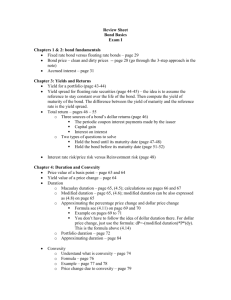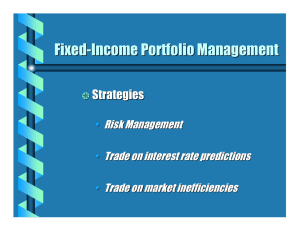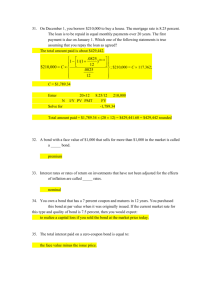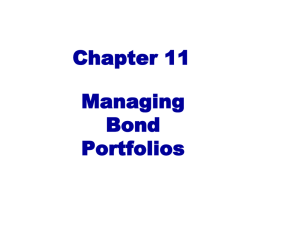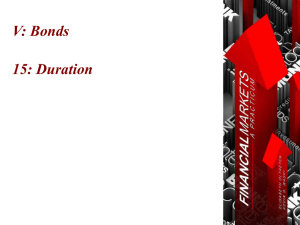Financial Risk Management of Insurance Enterprises
advertisement
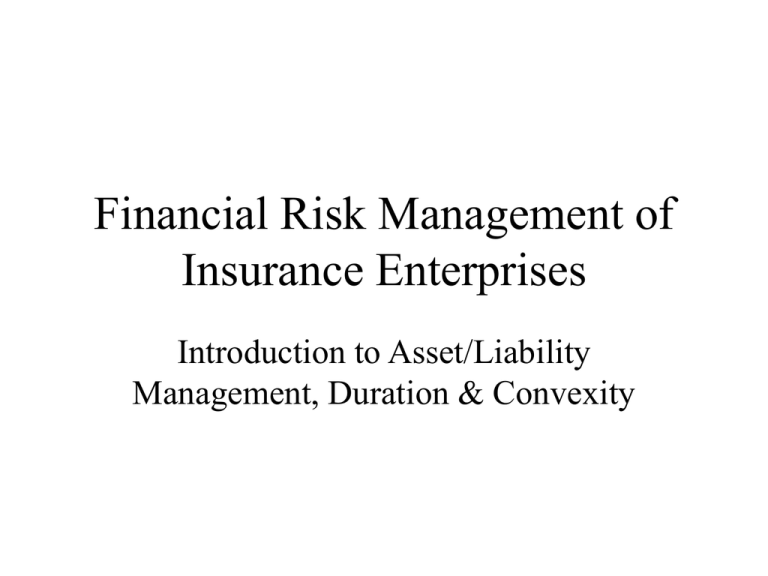
Financial Risk Management of Insurance Enterprises Introduction to Asset/Liability Management, Duration & Convexity Review... • For the first part of the course, we have discussed: – – – – The need for financial risk management How to value fixed cash flows Basic derivative securities Credit derivatives • We will now discuss techniques used to evaluate asset and liability risk Today • An introduction to the asset/liability management (ALM) process – What is the goal of ALM? • The concepts of duration and convexity – Extremely important for insurance enterprises Asset/Liability Management • As its name suggests, ALM involves the process of analyzing the interaction of assets and liabilities • In its broadest meaning, ALM refers to the process of maximizing risk-adjusted return • Risk refers to the variance (or standard deviation) of earnings • More risk in the surplus position (assets minus liabilities) requires extra capital for protection of policyholders The ALM Process • Firms forecast earnings and surplus based on “best estimate” or “most probable” assumptions with respect to: – Sales or market share – The future level of interest rates or the business activity – Lapse rates – Loss development • ALM tests the sensitivity of results for changes in these variables ALM of Insurers • For insurance enterprises, ALM has come to mean equating the interest rate sensitivity of assets and liabilities – As interest rates change, the surplus of the insurer is unaffected • ALM can incorporate more risk types than interest rate risk (e.g., business, liquidity, credit, catastrophes, etc.) • We will start with the insurers’ view of ALM The Goal of ALM • If the liabilities of the insurer are fixed, investing in zero coupon bonds with payoffs identical to the liabilities will have no risk • This is called cash flow matching • Liabilities of insurance enterprises are not fixed – Policyholders can withdraw cash – Hurricane frequency and severity cannot be predicted – Payments to pension beneficiaries are affected by death, retirement rates, withdrawal – Loss development patterns change The Goal of ALM (p.2) • If assets can be purchased to replicate the liabilities in every potential future state of nature, there would be no risk • The goal of ALM is to analyze how assets and liabilities move to changes in interest rates and other variables • We will need tools to quantify the risk in the assets AND liabilities Price/Yield Relationship • Recall that bond prices move inversely with interest rates • For option-free bonds, this curve is not linear but convex Price – As interest rates increase, present value of fixed cash flows decrease P rice/yield curve Yield Simplifications • Fixed income, non-callable bonds • Flat yield curve • Parallel shifts in the yield curve Examining Interest Rate Sensitivity • Start with two $1000 face value zero coupon bonds • One 5 year bond and one 10 year bond • Assume current interest rates are 8% Price Changes on Two Zero Coupon Bonds Initial Interest Rate = 8% Principa l 1000 1000 1000 1000 1000 1000 1000 R 0.06 0.07 0.0799 0.08 0.0801 0.09 0.1 5 ye a r Cha nge 747.2582 9.7967% 712.9862 4.7611% 680.8984 0.0463% 680.5832 0.0000% 680.2682 -0.0463% 649.9314 -4.5038% 620.9213 -8.7663% 10 ye a r Cha nge 558.3948 20.5532% 508.3493 9.7488% 463.6226 0.0926% 463.1935 0.0000% 462.7648 -0.0925% 422.4108 -8.8047% 385.5433 -16.7641% Price Volatility Characteristics of Option-Free Bonds Properties 1 All prices move in opposite direction of change in yield, but the change differs by bond 2+3 The percentage price change is not the same for increases and decreases in yields 4 Percentage price increases are greater than decreases for a given change in basis points Characteristics 1 For a given term to maturity and initial yield, the lower the coupon rate the greater the price volatility 2 For a given coupon rate and intitial yield, the longer the term to maturity, the greater the price volatility Macaulay Duration • Developed in 1938 to measure price sensitivity of bonds to interest rate changes • Macaulay used the weighted average termto-maturity as a measure of interest sensitivity • As we will see, this is related to interest rate sensitivity Macaulay Duration (p.2) t PVCFt Macaulay Duration = t 1 k PVTCFt t index for period n n = total number of period k = number of coupon payments per year PVCFt Present value of cash flow in period t PVTCFt = Total present value of cash flows (price) Applying Macaulay Duration • For a zero coupon bond, the Macaulay duration is equal to maturity • For coupon bonds, the duration is less than its maturity • For two bonds with the same maturity, the bond with the lower coupon has higher duration Percentage change in price 1 Macaulay duration Yield change 100 yield 1 k Modified Duration • Another measure of price sensitivity is determined by the slope of the price/yield curve • When we divide the slope by the current price, we get a duration measure called modified duration • The formula for the predicted price change of a bond using Macaulay duration is based on the first derivative of price with respect to yield (or interest rate) Modified Duration and Macaulay Duration CFt P (1 i )t t CFt 1 P 1 Modified duration t 1 i P (1 i ) P 1 Macaulay duration (1 i ) i = yield P = price CF = Cash flow An Example Calculate: What is the modified duration of a 3-year, 3% bond if interest rates are 5%? Solution to Example Pe rio d C a sh F lo w PV t x PV 1 3 2.86 2.86 2 3 2.72 5.44 3 103 88.98 266.93 T otal 94.55 275.23 275.23 Macaulay duration = 2.91 94.55 2.91 Modified duration = 2.77 105 . Example Continued • What is the predicted price change of the 3 year, 3% coupon bond if interest rates increase to 6%? Example Continued • What is the predicted price change of the 3 year, 3% coupon bond if interest rates increase to 6%? % Price Change = Modified Duration Yield Change = -2.77 .01 = -2.77% Other Interest Rate Sensitivity Measures • Instead of expressing duration in percentage terms, dollar duration gives the absolute dollar change in bond value – Multiply the modified duration by the yield change and the initial price • Present Value of a Basis Point (PVBP) is the dollar duration of a bond for a one basis point movement in the interest rate – This is also known as the dollar value of an 01 (DV01) A Different Methodology • The “Valuation…” book does not use the formulae shown here • Instead, duration can be computed numerically – Calculate the price change given an increase in interest rates of ∆i – Numerically calculate the derivative using actual bond prices: P Duration = P i A Different Methodology (p.2) • Can improve the results of the numerical procedure by repeating the calculation using an interest rate change of -∆i • Duration then becomes an average of the two calculations Error in Price Predictions – The estimate is linear • Because the price/ yield curve is convex, it lies above the tangent line • Our estimate of price is always understated Price • The estimate of the change in bond price is at one point Yield Figure 2-A Present Value of a $1 Million Ten Year Zero Coupon Bond with Taylor Series Approximations $1,200,000.00 $1,000,000.00 $800,000.00 Present Value $600,000.00 Bond Value First Order Second Order Third Order Fourth Order $400,000.00 $200,000.00 $0 0.05 0.1 0.15 $(200,000.00) $(400,000.00) Interest Rate 0.2 0.25 0.3 Convexity • Our estimate of percentage changes in price is a first order approximation • If the change in interest rates is very large, our price estimate has a larger error – Duration is only accurate for small changes in interest rates • Convexity provides a second order approximation of the bond’s sensitivity to changes in the interest rate – Captures the curvature in the price/yield curve Computing Convexity • Take the second derivative of price with respect to the interest rate 2 P 1 t CFt 1 Convexity 2 t 1 i P i (1 i ) P t (t 1) CFt 1 t 2 (1 i ) P t (t 1) CFt 1 1 2 P (1 i ) (1 i ) t Example • What is the convexity of the 3-year, 3% bond with the current yield at 5%? Period Cash Flow PV t x PV t x (t+1) x PV 1 3 2 .8 6 2 .8 6 5 .7 1 2 3 2 .7 2 5 .4 4 1 6 .3 3 3 103 8 8 .9 8 2 6 6 .9 3 1 ,0 6 7 .7 0 T o ta l 9 4 .5 5 2 7 5 .2 3 1 ,0 8 9 .7 4 1,089.74 Convexity 10.46 2 1.05 94.55 Predicting Price with Convexity • By including convexity, we can improve our estimates for predicting price Percentage Price Change = - Modified Duration Yield Change 1 + Convexity (Yield Change) 2 2 An Example of Predictions • Let’s see how close our estimates are Original Bond Price at 5% = 94.55 Prediction at 6% using Duration = 94.55 0.9723 = 91.93 Percentage Change with Convexity = -2.77 .01+ 0.5 10.86.012 2.72% Estimated Price with Convexity = 94.55 0.9728 = 91.98 Actual Price at 6% = 91.98 Notes about Convexity • Again, the “Valuation…” textbook computes convexity numerically, not by formula • Also, “Valuation…” defines convexity differently – It includes the ½ term used in estimating the price change in the definition of convexity Convexity is Good • In our price/yield curve, we can see that as interest increases, prices fall • As interest increases, the slope flattens out – The rate of price depreciation decreases • As interest decreases, the slope steepens – The rate of price appreciation increases • For a bondholder, this convexity effect is desirable Next Time • Limitations to duration calculations • Effective duration and convexity • Other duration measures

